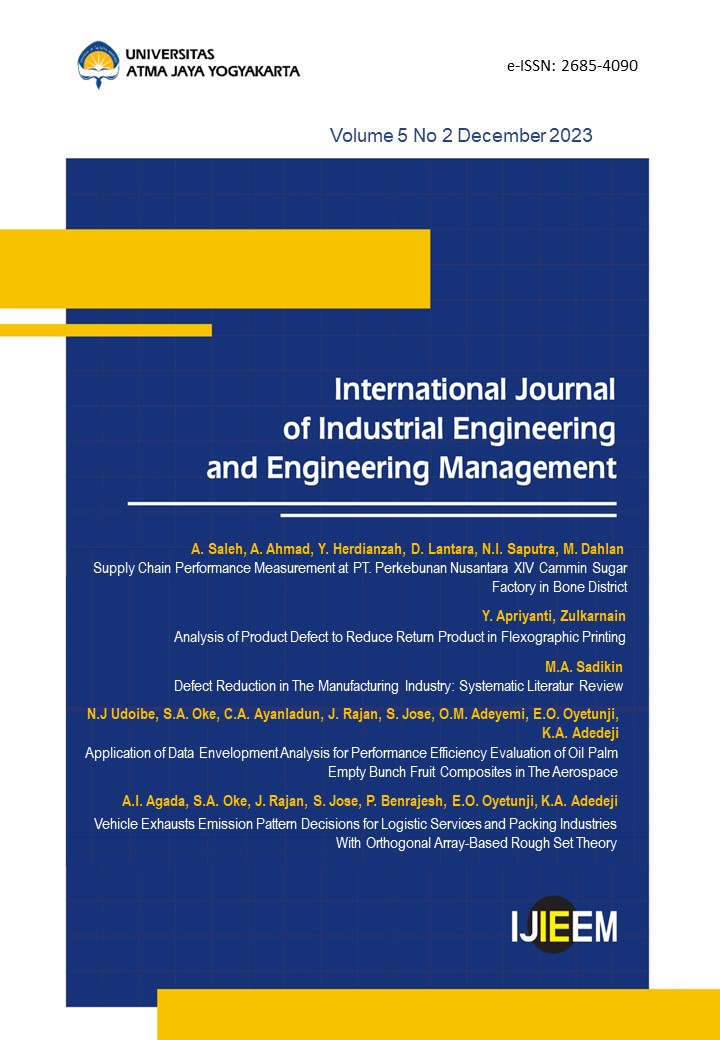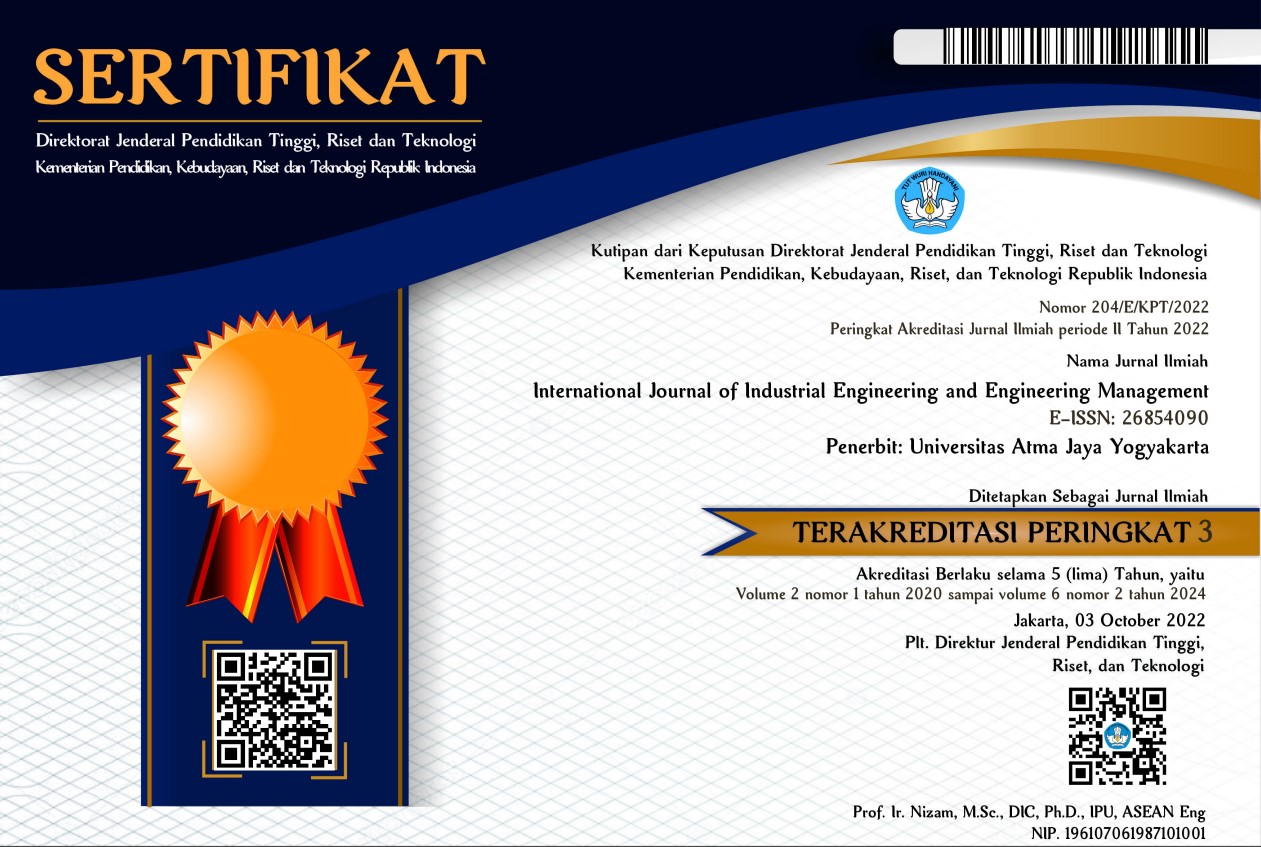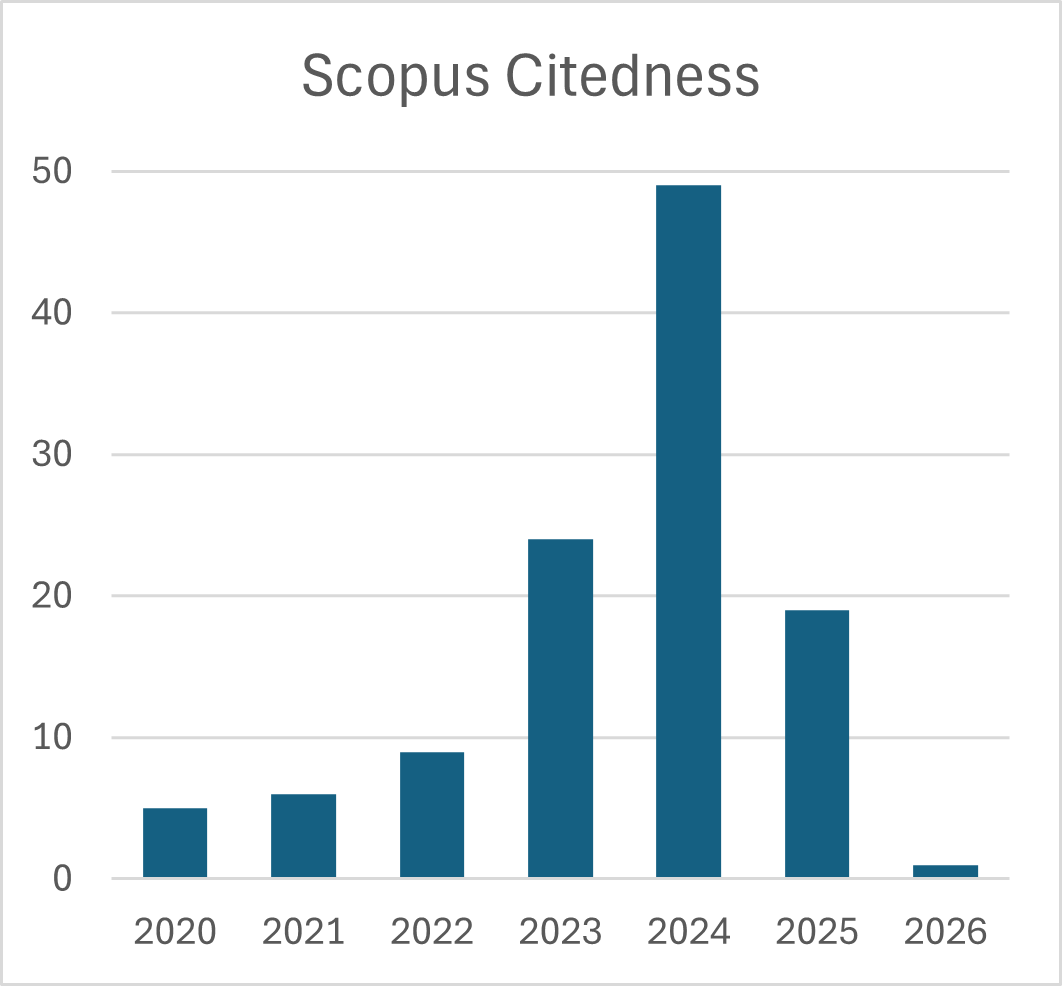Application of Data Envelopment Analysis for Performance Efficiency Evaluation of Oil Palm Empty Bunch Fruit Composites in The Aerospace Industry
DOI:
https://doi.org/10.24002/ijieem.v5i2.7741Keywords:
decision making, performance measurement, inputs, outputs, linear programmingAbstract
In this study, we propose the data envelopment analysis method as a scheme to determine the technical efficiency of a set of parametric inputs of the water absorption process when developing the oil palm particulate composite treated with an alkali solution. Although alkali-treated oil palm bunch composites have been analyzed previously for water absorption, a single parameter such as water absorption rate prevails in analyses. Unfortunately, multiple inputs and multiple outputs have been ignored and the efficiency evaluation of such composites has been missing in the literature. To address this gap, the present study exploits the linear programming theory and formulated models for each decision-making unit and solves that formulation for optimum value determination for inputs of the composites. This study investigates the technical efficiency of the water absorption in the oil palm empty fruit bunch composite development process. Overall, judging the performance of the parameters regarding the frequency of attaining 100% efficiency, analysis was performed on the average performance of all parameters in all sixteen scenarios. In this regard, the efficiency of particulate loading was 36.1%, for composite weight plus mold, it was 96.3% and for initial weight, the average efficiency score was 67.8%. It is suggestive that composite weight plus mold with an average efficiency of 96.3% is the best parameter while particulate loading with 36.1% is the worst parameter. Thus result is consistent with the result based on each scenario. From the perspective of DMUs, DMU11 with a score of 78.4% is the best ranking unit while DMU14 is the work ranking unit with an efficiency score of 60.9%. Besides, the average efficiency score for all the DMUs is 66.7%. The work is important to composite development engineers and for policy decision-making.
References
Abdullah, M.A., Nazir, M.S., Raza, M.R., Wahjoedi, B.A., & Yussof, A.W. (2016). Autoclave and ultra-sonication treatments of oil palm empty fruit bunch fibers for cellulose extraction and its polypropylene composite. Journal of Cleaner Production, 126, 686-697.
Achoja, F. O., Okoh, R.N., & Osilama, C.O. (2019). Marketing of palm oil wastes: Economic and environmental benefits in Nigeria. Adul Ziraat Derg, 16(2), 129-133.
Ahmad, N.M., Ishak, R.M., Taha, M.M., Mustapha, F., Leman, Z., & Irianto. (2023). Mechanical, thermal and physical characteristics of oil palm (elaeis guineeensis) fiber reinforced thermoplastic composites for FDM-Type 3D printer. Polymer Testing, 120, Article 107972.
Ahmad, F., Abbas, Z., Obaiys, S.J., Ibrahim, N.A., Zainuddin, M.F., & Salem, A. (2016). Permittivity properties of Nickel Zinc Ferrite-oil Palm Empty Fruit Bunch-Polycaprolactone Composite. Procedia Chemistry, 19, 503-610.
Alam, M.A.K.M., Beg, M.D.H., Mina, M.F., Mamun, A.A., & Bledzki, A.K. (2014). Degradation and stability of green composites fabricate from oil palm empty fruit bunch fibre and polylactic acid: Effect of fibre length. Journal of Composite Materials, 49(25), 1-12.
Amir, S.M.M., Sultan, M.T.H., Jawaid, M., Safri, S.N.A., Shah, A.U.M., Yusof, M.R., Naveen, J., Mohd, S., Salleh, K.A.M., &Saba, N. (2019).
Effects of layering sequence and gamma radiation on mechanical properties and morphology of Kevlar/oil palm EFB/epoxy hybrid composites. Journal of Materials Research and Technology, 8(6), 5362-5373.
Chaiwang, W., Samoh, N., Eksomtranmage, T., & Kaewtatip, K. (2019). Surface-treated oil palm fruit bunch fibre improved tensile strength and water resistance of wheat gluten-based bioplastic. Composites Part B, 176, Article 107331.
Charnes, A., Cooper, W.W., & Rhodes, E. (1978). Measuring the efficiency of decision making units. European Journal of Operation Research, 2(6), 429-444.
De Castro-Pardo, M., Martinez, P.F., & Zabaleta A.P. (2022). An initial assessment of water security in Europe using a DEA approach. Sustainable Technology and Entrepreneurship, 1, Article 100002.
Gennitsaris, S., Sagani, A., Sofianopoulou, S., & Dedoussis, V. (2023). Integrated LCA and DEA approach for air circular economy-driven performance evaluation of wind turbine end-of-life treatment options. Applied Energy, 339, Article 120951.
Hamid, M.Z.A., Ibrahim, N. A., & Yunus, W.M.Z.W. (2010). Effect of grafting on properties of oil palm empty fruit bunch fiber, reinforced polycaprolactone biocomposites. Journal of Reinforced Plastics and Composites, 29(18), 2723-2731.
Hermawan, D., Hazwan, M.C., Owolabi F.A.T., Gopakumar, A.D., Hassan, M., Rizal, S., Aprilla, S. N.A., Mohamed, A.R., & Khalil, A.H.P.S. (2019). Oil palm microfiber-reinforced hand sheet Molded thermoplastic green composites for sustainable packaging applications. Progress in Rubber, Plastics and Recycling Technology, 35(4), 1-15.
Ismail, H., Jaffri, R.M., & Rozman, H.D. (2000). Oil palm wood flour filled national rubber composites: fatigue and hysteresis behavior. Polymer International, 49(6), 618-622.
Ibrahim, N.A., Hashim, N.I., Rahman, M.Z.A., Yunus, W.M.Z.W. (2011). Mechanical properties and morphology of oil palm empty fruit bunch-polypropylene composites: Effect of adding ENGAGE. Journal of Thermoplastic Composite Materials, 24(5), 713-732.
Islam, M.A., Gupta, A., Rivai, M., & Beg, M.D.H. (2015). Characterization of microwave-treated oil palm empty fruit bunch/glass fiber/polypropylene composites. Journal of Thermoplastic Composite Materials, 30(7), 1-7.
Izah, S.C., Angaye, T.C.N., & Ohmain, E.I. (2016), Environmental impacts of oil palm process in Nigeria. Biotechnological Research, 2(3), 132-141.
Izani, M.A.N., Paridah, M.T., Anwar, U.M.K., Nor, M.Y.M., & Hing, P.S. (2013). Effects of fibre treatment on morphology, tensile and thermogravimetric analysis of oil palm empty fruit bunches fibers. Composites: Part B, 45(1), 1251-1257.
Jawaid, M., Khalil, A.H.P.S., Bakar, A.A., Hassan, A., & Dungani, A. (2012). Effect of jute fiber loading on the mechanical and thermal properties of oil palm-epoxy composites. Journal of Composite Materials, 45(1), 1633-1641.
Jawaid, M., Kalil, H.P.S.A., & Bakar, A.A. (2010). Mechanical performance of oil palm empty fruit bunches/jute fibers reinforced epoxy hybrid composites. Material Science and Engineering: A, 527(29-30), 7944-7949.
Kalam, A., Sahari, B.B., Kalid, Y.A., & Wong, S.V. (2005). Fatigue behaviors of oil palm fruit bunch fiber/epoxy and carbon fiber/epoxy composites. Composite Structures, 71(1), 34-44.
Khalil, A.H.P.S., Fazita, M.R.N., Jawaid, M., Bhat, A.H., & Abdullah, C.K. (2011). Empty fruit bunches as a reinforcement in laminated bio-composites. Journal of Composite Materials, 45(2), 219-236.
Khalil, A.H.P.S., Ismail, H., Ahmad, M.N., Ariffin, A. & Hassan, K. (2001). The effect of various anhydride modification on mechanical and water absorption properties of oil palm empty fruit bunches reinforced polyester composites. Polymer International, 50(4), 395-402.
Kittikorn, T., Stromberg, E., Ek, M., & Karlsson, S. (2012). The Effect of surface modifications on the mechanical and thermal properties of empty fruit bunch oil palm fiber PP bio composites. Polymers from Renewable Resources, 3(3), 79-100.
Latip, N.A., Sofian, A.H., Ali, M.F., Ismail, S.N., & Idris, D.M.N.D. (2019). Structural and morphological studies on alkaline pre-treatment of oil palm empty fruit bunch (OPEFB) fiber for composite production. Materials Today: Proceedings, 17, 1105-1111.
Michali, M., Emrouznejad, A., Dehnokhalaji, A., & Chegg, B. (2021). Noise-pollution efficiency analysis of European railways: A network DEA model. Transportation Research Part D: Transport and Environment, 98, Article 102980.
Nassiri, S.M., & Singh, S. (2010). A comparative study of parametric and non-parametric energy use efficiency in paddy production. Journal of Agricultural Science and Technology, 12(4), 391-399.
Nordin, A.N., Rahman, N.M.M., & Hassan, A. (2020). Conditioning effects on the mechanical and thermal properties of heat-treated oil palm empty fruit bunch/high-density polyethylene composite. High Performance Polymers, 32(2), 158-167.
Ogunbode, T.O., Aliku, O., Ogungbile, P.O., Olatubi, I.V., & Adeniyi, V.A. (2022). Environmental impact of oil palm processing on some properties of the on-site soil in a growing city in Nigeria. Frontiers in Environmental Science, 10, Article 918478.
Pourbabagol T., Amiri M., Taghavifard, M.T., & Hanafizadeh, P. (2023). A new fuzzy DEA network based on possibility and necessity measured for agile supply chain performance evaluation. A case study, Expert Systems with Applications, 220, Article 119552.
Ramlee, N.A., Jawaid, M., Zainudin, E.S., & Yamani, S.A.K. (2019). Tensile, physical, and morphological properties of oil palm empty fruit bunch/sugarcane bagasse fiber reinforced phenolic hybrid composites. Journal of Materials Research and Technology, 8(4), 3466-3474.
Ramli, R.I., Yunus, A.M., & Beg, M.D.H. (2011). Thermal gravimetric/fourier transform infrared spectroscopy analysis of oil palm fibre reinforced polypropylene composites. Journal of Thermoplastic Composite Materials, 26(4), 497-512.
Rebolledo-Leiva, R., Vasquez-Ibarra, L., Entrena-Barbero, E., Fernandez, M., Feijoo, G., Moreira, M.T., & Gonzalez-Garcia, S. (2022). Coupling material flow analysis and network DEA for the evaluation of eco-efficiency and circularity on dairy farms. Sustainable Production and Consumption, 31, 805-817.
Rozman, H.D., Lai, C.Y., Ismail, H., & Ishak, M.Z.A. (2000). The effect of coupling agents on the mechanical and physical properties of oil palm empty fruit bunch-polypropylene composites. Polymer International, 49(11), 1273-1278.
Rozman, H.D., Tay, G.S., Kumar, R.N., Abusamah, A., Ismail, H., & Ishak, Z.A.M. (2001). Polypropylene-oil palm empty fruit bunch-glass fiber hybrid composites: a preliminary study on the flexural and tensile properties. European polymer journal, 37(6), 1283-1291.
Rozman, H.D., Ahmadhilmi, K.R., & Abubakar, A. (2004). Polyurethane (PU) – oil palm empty fruit bunch (EFB) composites: The effect of EFBG reinforcement in mat form and isocyanate treatment on the mechanical properties. Polymer Testing, 23(5), 559-565.
Saba, N., Jawaid M., Alothman O.Y., & Almutairi Z. (2019). Evaluation of dynamic properties of nano oil palm empty fruit bunch filler/epoxy composites. Journal of Materials Research and Technology, 8(1), 1470-1475.
Shwartz, M., & Burgess, J.F. (2016). A DEA-based composite measure of quality and its associated data uncertainty interval for health care provider profiling and pay-for-performance. European Journal of Operational Research, 253(2), 489-502.
Tay, G.S., Shannon-Ong, S.H., Goh, S.W., & Rozman, H.D. (2011). Thermoplastic-lignocellulose composites enhanced by chemically treated Alcell lignin as a compatibilizer. Journal of Thermoplastic Composite Materials, 26(6), 733-746.
Zhang, C., Wang, Z., Su, W, & Dali, S. (2024). Differentiated power rationing or seasonal power price? Optimal power allocation solution for Chinese industrial enterprises based on the CSW-DEA model. Applied Energy, 353, Article 122150.
Downloads
Published
How to Cite
Issue
Section
License
Copyright (c) 2023 Ndifreke John Udoibe, Sunday Ayoola Oke, Chris Abiodun Ayanladun, John Rajan, Swaminathan Jose, Olusola Michael Adeyemi, Elkanah Olaosebikan Oyetunji, Kasali Aderinmoye Adedeji

This work is licensed under a Creative Commons Attribution 4.0 International License.








